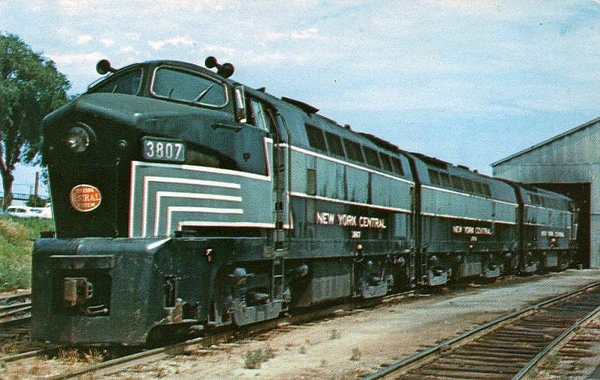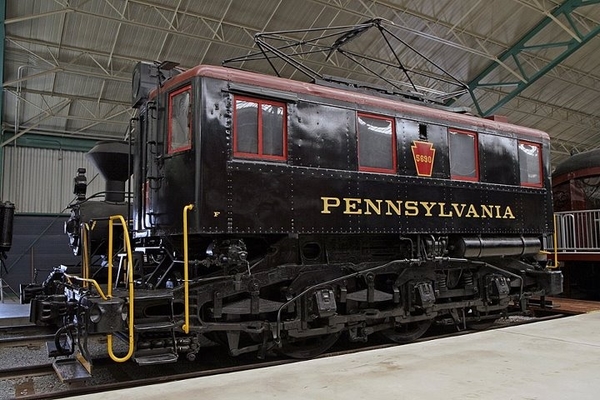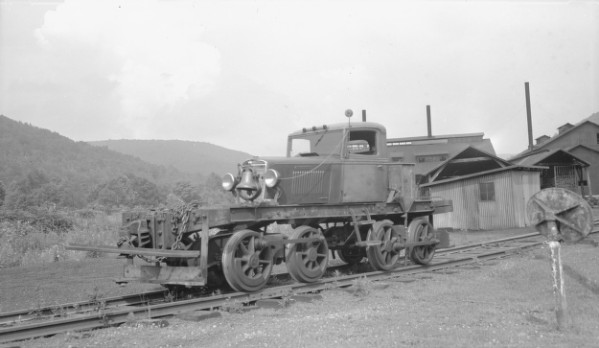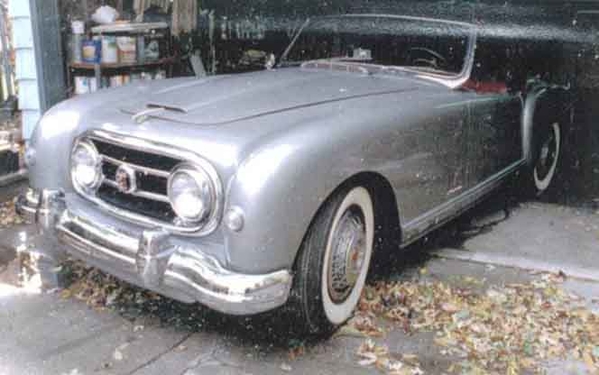This livery strikes me as dignified, in the same way as WWII-era military dress uniforms. On the other hand, the Amfleet cars have the dignity of a Campbell soup can.
|




|
This livery strikes me as dignified, in the same way as WWII-era military dress uniforms. On the other hand, the Amfleet cars have the dignity of a Campbell soup can.
Vincent Massi posted:
Not the same model, but you can get an o gauge beyer-garret from ETS
While many such engines where built from 2’ gauge to South African “cape gauge”, to meter gauge to even over 5’ wide gauge, not that many were standard gauge. That being said, our friends Down Under has a few... Check out this Aussie Loco
Here’s a company flyer. Used almost everywhere but the U S of A
I had gotten interested in “sharks,” often called “sharknose” diesels.
interested in “sharks,” often called “sharknose” diesels.
The PRR designed three types which were built by Baldwin from 1945 to 1953. They then built various improved models within those three types. The sharknose design was done to distinguish them from competitors and from earlier less-successful diesels.
Although the PRR was the primary purchaser, other railroads, including Soviet Railways, bought some. The last two went out of service in 1981.
Vincent Massi posted:I had gotten
interested in “sharks,” often called “sharknose” diesels.
The PRR designed three types which were built by Baldwin from 1945 to 1953. They then built various improved models within those three types. The sharknose design was done to distinguish them from competitors and from earlier less-successful diesels.
Although the PRR was the primary purchaser, other railroads, including Soviet Railways, bought some. The last two went out of service in 1981.
SAY WHAAAA????
The RF16 was designed and built by the Baldwin-Lima-Hamilton Locomotive Works. While the "Sharknose" design may have been influenced by the Pennsy T1, the Pennsy didn't design them.
Pennsylvania, New York Central, Baltimore & Ohio and Elgin, Joliet & Eastern (ex-RF16 Demo's) were the only buyers. Monongahela Railway bought seven A's and two B's RF16's second hand from the NYC and Delaware & Hudson bought two A's from the Monongahela.
None went to Russia.
Rusty
The Sharknose was designed by Raymond Loewy.
Baldwin 2-6-2t?
Bought for and used in France for WW1, then used stateside in various places after the war for the Army and various civilian owners later.
Bachmann is coming out with an On30 model of this, just got announced.
HECK YES, I'll be buying one! I've been hoping for a good kit for one of these, but Bachmann making a RTR one is more than I could have hoped for.
I have an Army RR Operating unit on my layout which takes place in 1943. They were still using these at that point stateside and it'll make a lot more sense than the 50-tonner Whitcomb (which did exist at that time but unlikely would be used by a training unit) that I have right now for their use...
Vincent Massi posted:
http://freedomtrain.org/freedo...-locomotive-1776.htm
My Dad got to see the train in Johnson City, TN when he was 12: https://www.freedomtrain.org/f...-johnson-city-tn.htm
He then got to see the 1975-76 version in Florida near the end of it's run before Thanksgiving 1976. I saw the 4449/bicentennial version just before my 7th birthday and remember it like it was yesterday!
Vincent Massi posted:Baldwin Locomotive only built four of these magnificent C-16 dockside switchers. Model railroad companies manufactured thousands of them.
Thousands? I would say hundreds of thousands, maybe even millions! ![]() Even that paragon of importers, International Models, did it in O; I even have one. I suspect the only model that exceeds the production quantities of the C-16 is the Globe/Athearn F7!
Even that paragon of importers, International Models, did it in O; I even have one. I suspect the only model that exceeds the production quantities of the C-16 is the Globe/Athearn F7!
Four different versions of these 42 beauties were manufactured from 1926 to 1935, with Pennsylvania Railroad buying all of them. Three of the versions were designed to be used in pairs, but as improvements were made over the decades, all of them were eventually used singly.
I can't find out when they went out of service, but Penn Central inherited some in 1968. The only survivor is in a museum. 


There really was such a device, made from left-over parts. The motor sits on top of the chassis and uses a worm drive to connect to the wheels underneath the chassis. You cannot see the worm drive because the wheels are blocking your view.
It SEEMS to be using the truck's motor. But in that case, why not simply attach railroad wheels to the truck and use it as a locomotive? It is also possible that a more powerful motor was used, and the truck body merely covered the motor.
Obviously, the device was impractical, but it really did run, serving a wood chemical plant in Pennsylvania.
A total turn-off. Back when locos of this type were common, they were brightly painted kept in pristine condition. In general, an engineer was assigned a locomotive and it was his responsibility, and a matter of personal pride, to keep it looking good! (Sort of like my Dad and his car.)
Kent Loudon posted:A total turn-off. Back when locos of this type were common, they were brightly painted kept in pristine condition. In general, an engineer was assigned a locomotive and it was his responsibility, and a matter of personal pride, to keep it looking good! (Sort of like my Dad and his car.)
Correct. Even during the Civil War locomotives didn't look that bad. Nashville 1864:
Even this one which sustained damage:
Locomotives going to scrap didn't look as bad as the movie prop locomotive:
Rusty
Kent Loudon posted:This livery strikes me as dignified, in the same way as WWII-era military dress uniforms.
Did you know the WW2 uniform style is coming back for the US Army? Why didn't they do this when I was still active duty?
I know it's way off subject, but I couldn't resist..
Vincent Massi posted:
What movies or shows has this thing been in? I know the **** on Wheels and Lone Ranger movies had mock-ups, but this isn't either of those, and I can't think of any other movies that used to Makkah. Frankly, this one actually is very well made.
How would you like to own this beauty?
Not Lois Lane, you knucklehead (Her boyfriend is standing right there). I'm talking about the 1950 Nash Rambler.
 Over time, they "upgraded" Lois Lane's car with modifications to keep it looking like a new model.
Over time, they "upgraded" Lois Lane's car with modifications to keep it looking like a new model.
It sold for $25,500 in a 2017 auction. It got a higher price than some older, scarcer cars because, well, Lois Lane used to own it.
Vincent Massi posted:How would you like to own this beauty?
Not Lois Lane, you knucklehead (Her boyfriend is standing right there). I'm talking about the 1950 Nash Rambler.Over time, they "upgraded" Lois Lane's car with modifications to keep it looking like a new model.
It sold for $25,500 in a 2017 auction. It got a higher price than some older, scarcer cars because, well, Lois Lane used to own it.
Great, now you've got me thinking of the song "Beep, Beep."
Stuart
"How do you get this car out of second gear?"
PRRMP54 posted:"How do you get this car out of second gear?"
Ask Lois.
And speaking of Lois Lane, how do you explain the fact that you always beat her 

 to the scene of the crime? Why, you buy a 1953 Nash Healey convertible!
to the scene of the crime? Why, you buy a 1953 Nash Healey convertible!
America's first post WW2 sports car, it was expensive and fast. Its luxury interior actually included (Get this!) a built-in cigarette lighter!
Vague records tell us that actor Dick Powell actually owned the car, and he lent it to the Superman TV show for four scenes (in four different episodes). It APPEARS that the car was rented to different studios and appeared in at least one movie. It went through a variety of owners who may not have realized what it was. The current owner found it in poor condition and has restored it.
A drovers' caboose?
Cattle had to be allowed out of the railcars at regular intervals to exercise, drink, etc. The cattle handlers rode in drovers' cabooses which were sometimes put in the middle of the cattle cars so they could keep a better eye on things.
Often built from old passenger cars or boxcars, some of them were specially built from the ground up. Drovers' cabooses included sleeping and eating facilities. 


The Peacekeeper Rail Garrison is a mobile missile system that was developed by the United States Air Force during the 1980s as part of a plan to place fifty MGM-118A Peacekeeper[1] intercontinental ballistic missiles on the rail network of the United States. The railcars were intended, in case of increased threat of nuclear war, to be deployed onto the nation's rail network to avoid being destroyed by a first strike counterforce attack by the Soviet Union. However the plan was cancelled as part of defense cutbacks following the end of the Cold War, and the Peacekeeper missiles were installed in silo launchers as LGM-118s instead. 
Vincent Massi posted:The Peacekeeper Rail Garrison is a mobile missile system that was developed by the United States Air Force during the 1980s as part of a plan to place fifty MGM-118A Peacekeeper[1] intercontinental ballistic missiles on the rail network of the United States. The railcars were intended, in case of increased threat of nuclear war, to be deployed onto the nation's rail network to avoid being destroyed by a first strike counterforce attack by the Soviet Union. However the plan was cancelled as part of defense cutbacks following the end of the Cold War, and the Peacekeeper missiles were installed in silo launchers as LGM-118s instead.
My brother was a silo-based Peacekeeper ICBM launch officer and in the 90s, I got to go down into a LCC to see the launch control for ten missiles (each missile with ten Re-entry Vehicles, over 300 kiloton yield per RV). Very sobering.
We went out back at F E Warren AFB where the Rail Garrison facility was going to be built. Trains would take to the UP main at Cheyenne. He'd been told by contractors that the real missile trains would never take to the high iron unless they would be likely to launch them. They were using the by-then-defunct ground launched cruise missiles (tomahawks from trucks) play book as they never left their alert facility in peacetime either with nukes aboard.
The trains, I was told, were to be painted in real railroad markings, including weathering done with paint. Nobody connected could answer how they intended to fool train fans or RR employees, but this was the pre-internet era where by the time you heard about it, the nuclear war would have long already happened or the crisis was long over without going nuclear and the missiles were back in their facility.
The above car is at the USAF museum, the only surviving example of a transporter car, where the missile would rise out of the car and launch directly from it. Clearly, recovering the trains after launch was not a priority (as they'd be knocked off the tracks when the missile left) and I assume the crews were told once they launched, they were on their own?
I would.
rdg_fan posted:I would.
Ditto
Access to this requires an OGR Forum Supporting Membership
